Webpage Editor: F. NORTIER
Theory of the 2 Infinities
Representative : A. DEANDREA
Deputy Representative : S. HOHENEGGER
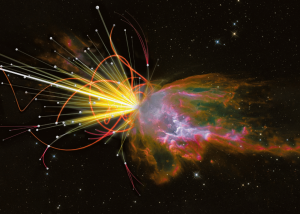
When the infinitely large meets the infinitely small.
The research activities conducted within the “Theory of 2 Infinities” hub at IP2I Lyon encompass a broad spectrum of subjects, ranging from the infinitely small to the infinitely large. These activities include the investigation of the properties of the fundamental constituents of matter, as well as inquiries into the large-scale structures of the universe. The primary objective is to develop theoretical models that elucidate experimental results or generate testable theoretical predictions. Our activities are structured around 3 principal research areas:
- Nuclei & Hadrons
- Elementary Particles
- Fields & Strings
and 3 cross-disciplinary research areas:
- Astrophysics & Cosmology
- Interdisciplinary Approaches
- Numerical Tools
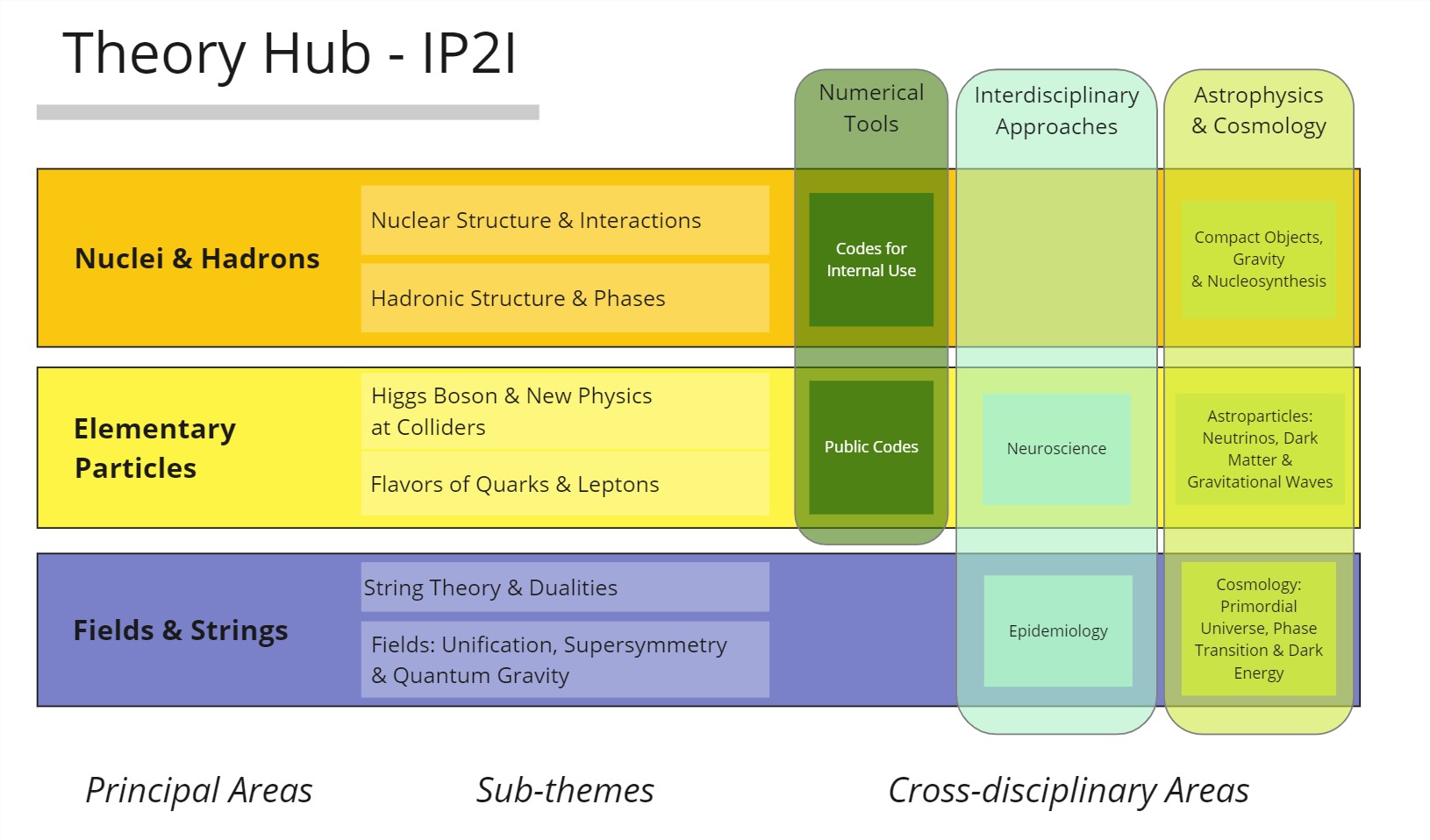
Moreover, we sustain robust connections and collaborative efforts with the following experimental research teams at IP2I:
NON-PERMANENTS:
- DOCTORANTS / DOCTORAL STUDENTS:
- CHERCHEURS NON-PERMANENTS / NON-PERMANENT RESEARCHERS:

Group photo from spring 2024.
Principal Research Areas
- Nuclei & Hadrons
- Nuclear Structure & Interactions
- Hadronic Structure & Phases
- Elementary Particles
- Higgs Boson & New Physics at Colliders
- Flavors of Quarks & Leptons
- Fields & Strings
- String Theory & Dualities
- Fields: Unification, Supersymmetry & Quantum Gravity
Area 1: Nuclei & Hadrons
Members: X. ARTRU (visitor), M. BENDER, K. BENNACEUR, G. CHANFRAY (emeritus), D. DAVESNE, M. ERICSON (emeritus), H. HANSEN, J. MARGUERON (on secondment), J. MEYER (emeritus) & J.-M. RICHARD (emeritus)
Nuclear and hadronic physics is devoted to the study of atomic nuclei and their fundamental constituents within the framework of quantum chromodynamics (QCD), specifically quarks and gluons. The phenomena under investigation span a wide range of energy scales, from relatively low-energy interactions to those occurring in extreme environments, such as the interiors of hot, dense stars.
Nuclear Structure & Interactions
Our research activities are centered on the following themes:
- Investigation of nuclear structure to support data acquisition and interpretation in current and future experimental facilities. This includes the analysis of nuclear masses, charge and mass density distributions, shell structure, collective motion, rotational bands, fission barriers, and contributions to nucleosynthesis studies, with a particular emphasis on the role of triaxial forms in these phenomena.
- Development of methods based on the nuclear energy density functional (EDF) to address the many-body nuclear problem, particularly through generalized forms of the EDF for the study of nuclear structure and the fitting of their parameters. This encompasses generalized Skyrme and Gogny EDFs, as well as the development of a new type of nonlocal EDF.
- Creation of numerical tools for nuclear structure physics, particularly for mean-field and configuration-mixing calculations of nuclei and nuclear matter based on nuclear EDFs. This includes calculations of the properties of complex-shaped nuclei that are almost free of symmetry restrictions.
- Development of models for neutrino interactions with nuclei, which are essential for the interpretation of neutrino oscillation experiments (such as T2K and DUNE), addressing the many-body problem and nucleon structure.
- Effective Relativistic Lagrangians: development of relativistic models for finite nuclei and uniform matter, aiming to bridge the gap between few-body and many-nucleon systems. This includes applications to the properties of finite nuclei in a deformed Hartree framework, the physics of neutron star crusts and cores, and hyperon interactions.
- The study of the stability of nuclei due to neutron-antineutron oscillations, in relation to experiments conducted on large underground detectors such as Super-Kamiokande and DUNE.
- Nuclear Astrophysics: development of a unified equation of state for the crust and core of neutron stars. Search for experimental (nuclear physics) and observational (gravitational waves, radio, X-ray) signals to better characterize the properties of the neutron star core, including the possible existence of a phase transition in the core. Development of an equation of state beyond the nucleonic metamodel. Design of open-access toolkits for the community, providing a large number of equations of state for neutron stars and analyzing gravitational wave sources.
Hadronic Structure & Phases
Our research is concentrated on the following topics:
- Relativistic Hartree-Fock Lagrangians with Confinement & Chiral Potential: Development of a theoretical framework within the context of the FMR that facilitates an explicit connection between the phenomenology of QCD, particularly the properties of the gluon correlator and Wilson loops (including string tension and gluon condensate), and the relativistic model for the description of nuclear matter and neutron stars.
- Multiquarks & Few-Body Systems: Investigation of the spectroscopy of multiquark states, such as tetraquarks and pentaquarks, and exploration of hypernuclei incorporating strange quarks. This research also encompasses the study of exotic atoms and hypernuclear maps.
- Hadronic Matter & Quark-Gluon Plasma: Analysis of the hot and dense phases of QCD, the search for a chiral critical point, and the understanding of the deconfinement phenomenon. This involves the development of effective quark models, with a particular focus on the high-density properties inferred from the spectra of gravitational waves emitted by neutron star mergers.

From standard hadrons to tetra- and pentaquarks. [source]
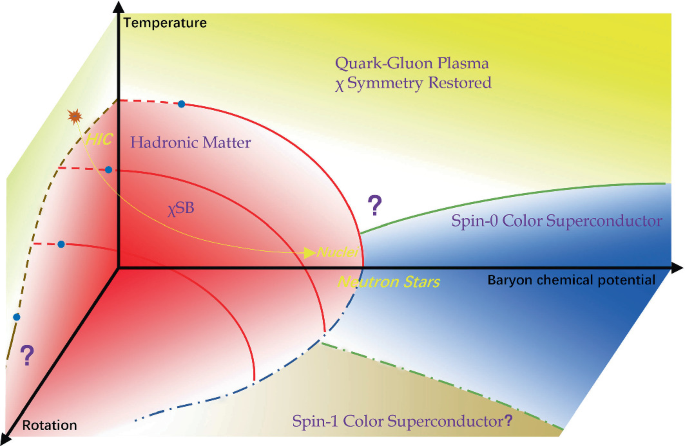
Phase diagram of quantum chromodynamics. [source]
Area 2: Elementary Particles
- Members (primary theme) : L. DARMÉ, S. DAVIDSON, A. DEANDREA, F.N. MAHMOUDI & F. NORTIER
- Members (secondary theme) : A. ARBEY, S. FRIOT (visitor) & H. HANSEN
High-energy physics is devoted to the study of fundamental interactions among elementary particles. The currently accepted theory of these interactions, the Standard Model, has demonstrated remarkable precision in describing the ultimate constituents of matter accessible through experimentation. However, there are substantial grounds to believe that this theory does not constitute a complete description of the laws of nature. Consequently, a portion of our research is dedicated to exploring various theories beyond the Standard Model, with the aim of elucidating this new physics.
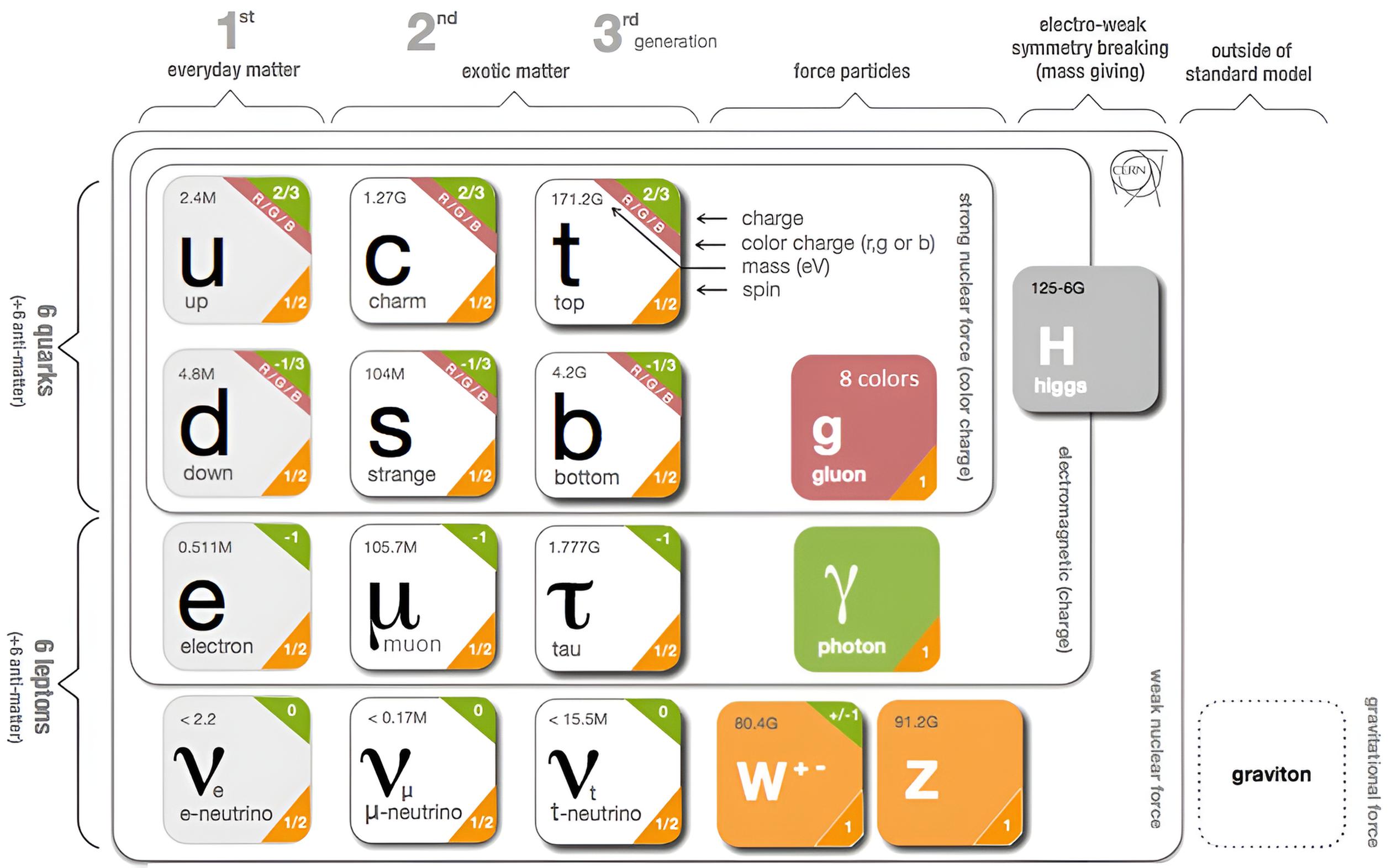
Table of elementary particles. [source]
Higgs Boson & New Physics at Colliders
High-energy particle colliders continue to yield unprecedentedly precise results in previously unexplored energy ranges. These results provide an opportunity to test theories beyond the Standard Model. In particular, the study of the Higgs boson, which is indicative of the mechanism responsible for conferring mass upon elementary particles, represents a significant challenge for experiments conducted in current and future colliders. This challenge is particularly pronounced due to the Higgs boson’s privileged role as a potential gateway to new physics. Furthermore, many models addressing the motivations underlying the existence of this new physics can be subjected to experimental scrutiny in these settings.

Simulation of the showers of subatomic particles produced in the CMS detector, during the collision of proton-proton beams at the CERN LHC. [source]
- Simplified models featuring an extended Higgs sector or vectorlike fermions;
- Models of dark matter and weakly interacting particles;
- Minimal supersymmetric extensions of the Standard Model;
- Intermediate-scale composite models for Higgs and top quark physics;
- Models incorporating extra dimensions and branes, along with their implications for gauge-Higgs unification scenarios and asymptotic grand unified theories;
- Ultraviolet/infrared (UV/IR) mixing and nonlocality, inspired by gravity and motivated by the little hierarchy problem;
- Extensions of the Standard Model involving Lorentz symmetry violation.
We are actively engaged in the development of computational tools and software packages (such as SuperIso, HyperIso, MARTY, and GAMBIT), with the primary objective of automating the calculation of observables in any new physics model.

Artistic illustration of various physics topics beyond the Standard Model, represented by islands separated by seas of unknowns. [source]
Flavors of Quarks & Leptons
Flavor physics occupies a central role in many of the unresolved mysteries of the Standard Model and is intricately linked to the Higgs sector through Yukawa couplings. Consequently, addressing the flavor puzzle entails endeavoring to elucidate the origins of several phenomena: the replication of fermions in generations, their mass hierarchy, the mass of neutrinos, the distinctive textures of quark and neutrino mixing matrices, and the matter-antimatter asymmetry through CP violation.
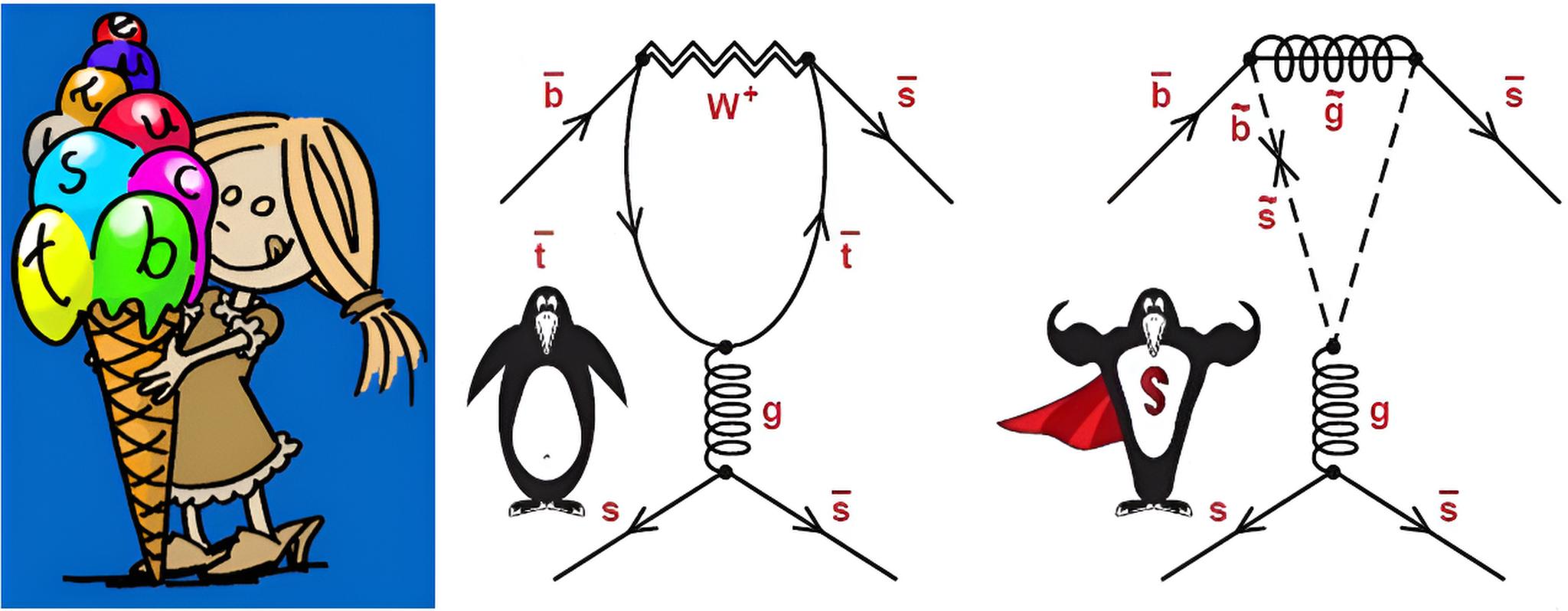
Left [source]: According to legend, Murray Gell-Mann and his student Harald Fritzsch conceived the idea of distinguishing quarks by their “flavor” and “color” in 1971, while sampling different flavors of ice cream. Center and right [source]: Examples of Feynman diagrams, referred to as “penguin” diagrams, in the context of flavor physics within the Standard Model (center) and in a supersymmetric extension (right).
Our field of study encompasses flavor physics in both the lepton and quark sectors, including models of leptogenesis and baryogenesis. We develop models featuring horizontal gauge symmetries aimed at resolving the flavor puzzle and analyze their phenomenological implications. Our research also focuses on the flavor anomalies observed in semi-leptonic decays of B mesons, while concurrently developing tools to mitigate uncertainties associated with hadronic form factors. Furthermore, we investigate phenomenological constraints on flavor change within the lepton sector, initiating collaborations with theoreticians in nuclear physics. The numerical codes developed for exploring new physics also find natural applications in the realm of flavor physics.
Area 3: Fields & Strings
- Members (primary theme) : S. FRIOT (visitor), F. GIERES, S. HOHENEGGER & D. TSIMPIS
- Members (secondary theme) : A. DEANDREA & F. NORTIER
Field theory constitutes the theoretical framework within which the theories of particle physics and gravitation are formulated. The challenge of achieving an ultraviolet completion of quantum gravity motivated the development of string theory. The pursuit of a non-perturbative formulation, known as “M-theory,” remains an active area of research to this day. However, recent applications of string theory have largely transcended its original framework. These applications have yielded numerous formal results in field theory, facilitating significant advances in the understanding of strongly coupled interactions within supersymmetric “toy” theories, as exemplified by the AdS/CFT correspondence and electric-magnetic duality. Furthermore, string theory has also spurred the study of nonlocal and/or noncommutative theories.

In string theory, elementary particles are conceptualized as one-dimensional strings that oscillate not only in the familiar spatial dimensions but also in compactified extra dimensions. These strings exhibit the property of attaching themselves to higher-dimensional solitonic objects known as branes. [source]
- Supersymmetric Gauge Theories: Supersymmetric field theories in 6 or fewer dimensions, characterized by diverse gauge and matter content, naturally emerge from various constructions of string theory (e.g., little string theory). Despite the general absence of explicit Lagrangian descriptions, computational methods derived from string theory facilitate the exploration of non-perturbative aspects and dualities within these theories. Through compactification or parameter space reduction, this also provides avenues for the study of 4-dimensional field theories and integrable systems.
- Cosmological Applications of String Theory: The realization of a de Sitter space, or more generally, accelerated expansion within a well-defined string theory model, remains a complex and unresolved question. Our work focuses on so-called “universal” compactification scenarios and their implications for quintessence and/or inflation. We also investigate higher-order terms in the action of bosonic strings for applications in cosmology.
- Mathematical Consistency of String Theory: The mathematical consistency of string theory imposes certain constraints on the geometry and topology of extra dimensions, particularly the compactification space. The properties of the latter are crucial for the phenomenology of 4-dimensional spacetime. We employ techniques at the interface of differential and algebraic geometry to characterize and classify the compactification spaces permitted by string theory. Our research also encompasses the study of scenarios involving fermionic condensation beyond simple Calabi-Yau compactifications.
- Mathematical Aspects of Field Theories: This theme focuses on the formal aspects of field theories, including (generalized) conserved charges and symmetries, as well as various quantization procedures. It also involves addressing the ghost problem in infinite-derivative (nonlocal) field theories and analyzing the spectrum of theories with extra spatial dimensions compactified on nilmanifolds.
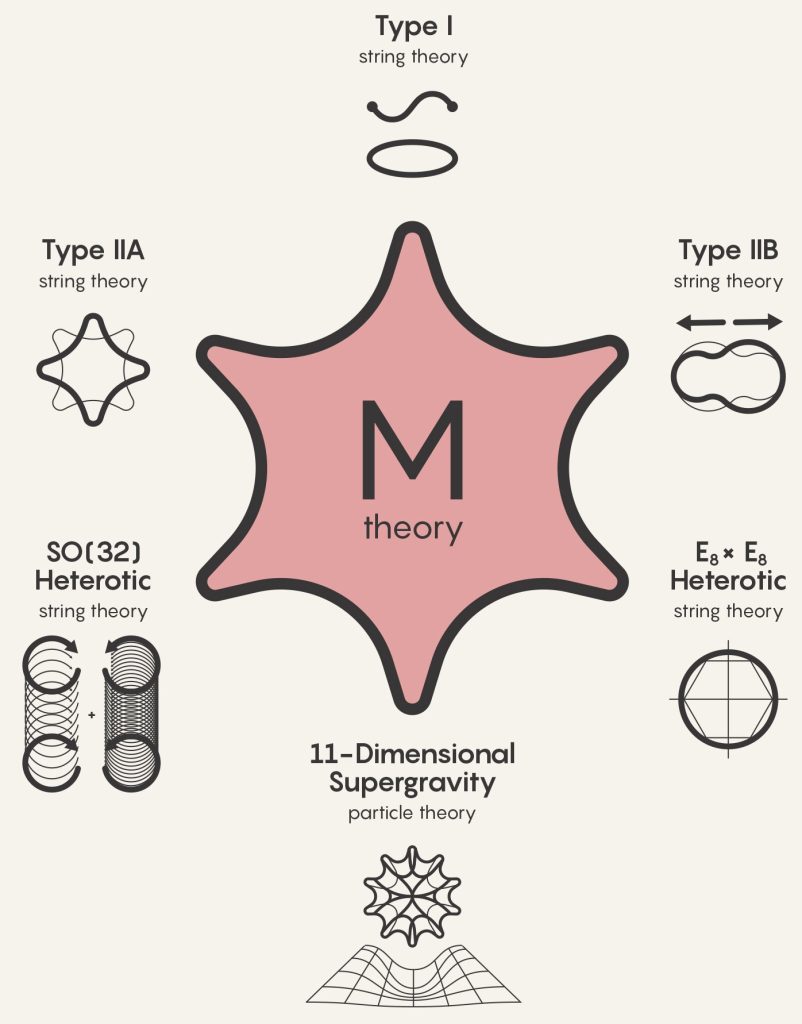
Duality web between the 5 superstring theories and supergravity. [source]
Cross-disciplinary Research Areas
- Astrophysics & Cosmology
- Compact Objects, Gravity & Nucleosynthesis
- Astroparticles: Neutrinos, Dark Matter & Gravitational Waves
- Cosmology: Primordial Universe, Phase Transition, and Dark Energy
- Interdisciplinary Approaches
- Epidemiology
- Neuroscience
- Numerical Tools
- Publics Code
- Codes for Internal Use
Area 1: Astrophysics & Cosmology
- Members (primary theme) : A. ARBEY, L. DARMÉ, H. HANSEN, S. HOHENEGGER, J. MARGUERON (on secondment) & D. TSIMPIS
- Members (secondary theme) : K. BENNACEUR, G. CHANFRAY (emeritus), S. DAVIDSON, A. DEANDREA, M. ERICSON (emeritus) & F.N. MAHMOUDI
Our 3 primary research areas find natural applications in the study of the infinitely large, encompassing the following domains:
- Nuclear Astrophysics: development of a unified equation of state for the crust and core of neutron stars. Search for experimental (nuclear physics) and observational (gravitational waves, radio, X-ray) signals to better characterize the properties of the neutron star core, including the possible existence of a phase transition in the core. Development of an equation of state beyond the nucleonic metamodel. Design of open-access toolkits for the community, providing a large number of equations of state for neutron stars and analyzing gravitational wave sources.
- Black Hole Physics: Development of the BlackHawk code for the automated calculation of Hawking radiation from Schwarzschild and Kerr black holes. This tool is designed for the study of primordial black holes and their impact on Big Bang nucleosynthesis, as well as for experiments in astroparticle physics. Concurrently, the investigation of quasi-normal modes facilitates the exploration of more exotic scenarios. Additionally, effective approaches are being developed to describe corrections, particularly quantum corrections, to classical black hole geometries (and the observables derived from them) within theories that extend beyond general relativity.
- Astroparticles & Cosmology: Examination of the interconnections between these 2 sectors, particularly in relation to dark matter and gravitational waves. Proposal of inflation models based on dark matter scenarios. Investigation of phase transitions in the early universe, integrating thermal field theory and gravitational waves, including their large-scale implications for flavor physics and potential new physics beyond the Standard Model.
- Cosmological Applications of String Theory: The realization of a de Sitter space, or more generally, accelerated expansion within a well-defined string theory model, remains a complex and unresolved question. Our work focuses on so-called “universal” compactification scenarios and their implications for quintessence and/or inflation. We also investigate higher-order terms in the action of bosonic strings for applications in cosmology.
The establishment of an experimental team focused on gravitational wave research at IP2I has facilitated novel collaborative opportunities between experimentalists and theorists. Notably, one of our members, H. Hansen, is an active contributor to the LVK collaboration, thereby further enhancing the connections between our institution and leading international initiatives in this field.



Top left [source]: Top left [source]: Simulation of the gravitational wave resulting from the merger of 2 black holes. Top right [source]: Pie chart of the current energy composition of the Universe. Bottom: The expanding Universe since the Big Bang and the appearance of the first stars 180 million years after the Big Bang (©AFP – N.R. FULLER / NATURE PUBLISHING GROUP / AFP).
Area 2: Interdisciplinary Approaches
Our commitment is exemplified through interdisciplinary projects at the interface of physics, mathematics, and health sciences. Indeed, the theoretical tools developed within the framework of the physics of the 2 infinites find applications in various fields of interdisciplinary research, particularly in the realm of health. This emerging theme holds considerable promise within our research group.
Epidemiology
Member: S. HOHENEGGER
We devise effective methodologies and renormalization group techniques to construct effective models describing the propagation of pathogens within populations. Techniques derived from information theory offer effective tools for monitoring and predicting pathogen adaptation to various environmental factors.

Epidemiology: an interdisciplinary science. [source]
Neuroscience
Member: A. ARBEY
We develop neural models grounded in statistical physics approaches, including the integration of Boltzmann equations within neural networks. Additionally, we employ Monte Carlo simulations to establish connections among behavioral, clinical, and neurological observations.
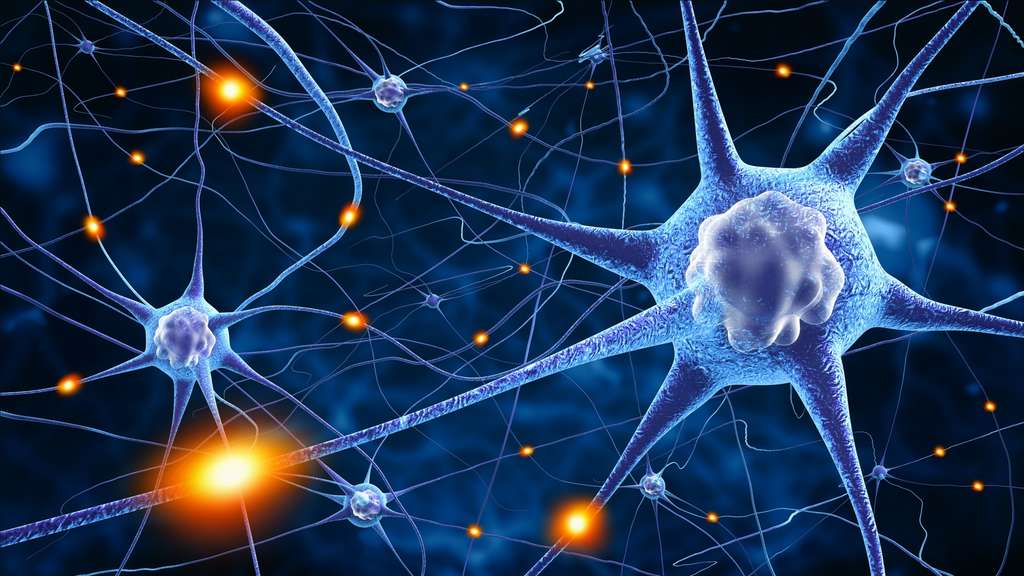
Artist’s impression of neural connections. [source]
Area 3: Numerical Tools
We possess substantial and recognized expertise in the development of numerical tools, both for our own research endeavors and for broader, open-access applications within the scientific community:
- Creation and development of general-purpose computational codes, such as SuperIso, HyperIso, MARTY, and GAMBIT, designed to reinterpret experimental results and explore new physical models.
- Development of a suite of specialized codes for specific applications across various research domains, including AlterBBN, BlackHawk, DarkEFT, DarkPACK, HFBRAD, HFODD, and SuperIso Relic, among others.

List of public codes developed by our members:
HFODD (1997)
Link: https://www.fuw.edu.pl/~dobaczew/hfodd/hfodd.html
Collaboration: The first publication about the HFODD code was authored by J. DOBACZEWSKI & J. DUDEK in 1997. Contributions have been made by K. BENNACEUR & M. BENDER since 2017.
Description: The code HFODD solves the nuclear Skyrme-Hartree-Fock or Skyrme-Hartree-Fock-Bogolyubov problem by using the Cartesian deformed harmonic-oscillator basis.
HFBRAD (2005)
Link: https://data.mendeley.com/datasets/4vzsg8tbr6/1
Author: K. BENNACEUR & J. DOBACZEWSKI
Description: First version (v1.00) of the code HFBRAD which solves the Skyrme-Hartree-Fock or Skyrme-Hartree-Fock-Bogolyubov equations in the coordinate representation within the spherical symmetry.
SuperIso (2007)
Link: http://superiso.in2p3.fr
Author: F.N. MAHMOUDI
Collaboration: Since version 4.1, S. NESHATPOUR participates to the development of SuperIso.
Description: Public code for computing flavor physics observables in the Standard Model and in new physics models.
SuperIso Relic (2009)
Link: http://superiso.in2p3.fr/relic
Authors: F.N. MAHMOUDI, A. ARBEY & G. ROBBINS
Description: SuperIso Relic is an extension of SuperIso for the calculation of the dark matter relic density and direct and indirect dark matter detection observables. A special feature of SuperIso Relic is that, in addition to the cosmological Standard Model, it allows the calculation of the relic density in alternative cosmological scenarios, thus allowing to test the influence of cosmological hypotheses.
AlterBBN (2012)
Link: https://alterbbn.hepforge.org/
Authors : A. ARBEY, J. AUFFINGER, K. HICKERSON & E. JENSSEN
Description: AlterBBN is a C program that calculates the abundances of elements predicted by Big Bang Nucleosynthesis (BBN). Different cosmological scenarios are implemented in AlterBBN, which can change the BBN predictions. In addition, AlterBBN is included in the SuperIso Relic package, so that alternative models can be tested using BBN constraints.
GAMBIT (2017)
Link: https://gambitbsm.org
Collaboration: The GAMBIT collaboration is made up of more than 70 international experts. F.N. MAHMOUDI is the coordinator of the physical part of flavors (FlavBit) and a member of the collaboration office.
Description: GAMBIT is a global fitting code for generic theories beyond the Standard Model, designed to allow rapid and easy definition of new models, observables, likelihoods and scanners, and to easily support new physics codes.
BlackHawk (2019)
Link: https://blackhawk.hepforge.org/
Authors: A. ARBEY & J. AUFFINGER
Description: BlackHawk is a public C program for computing Hawking evaporation spectra of any black hole distribution. This program allows users to compute primary and secondary spectra of stable or long-lived particles generated by Hawking radiation from the black hole distribution, and to study their evolution over time.
MARTY (2020)
Link: https://marty.in2p3.fr
Authors: G. UHLRICH, F.N. MAHMOUDI & A. ARBEY
Description: The goal of MARTY is to perform automatic calculations of amplitudes, cross sections, and Wilson coefficients in any new physics model. Some of its advantages are that MARTY is written entirely in C++, does not rely on proprietary code such as Wolfram Mathematica, and contains its own symbolic computation module (CSL), which can be used separately.
DarkEFT (2020)
Link: https://github.com/Luc-Darme/DarkEFT
Authors: L. DARMÉ, S.A.R. ELLIS, T. YOU
Description: DarkEFT is a Python tool to obtain the constraints on light dark sectors with fermion portal effective operators, based on existing and prospective experimental searches.
DarkPACK (2022)
Link: https://gitlab.in2p3.fr/darkpack/darkpack-public
Authors: M. PALMIOTTO, A. ARBEY & F.N. MAHMOUDI
Description: DarkPACK automatically generates a numerical library of scattering amplitudes in a given model to calculate dark matter observables, such as the relic density. DarkPACK is currently interfaced with MARTY and SuperIso Relic.
Research Grants
Agence Nationale de la Recherche (ANR)
RELANSE (2024)
Complete Title: Lagrangians for finite nuclei and dense matter
Coordinator: Jérôme MARGUERON
Co-workers: Guy CHANFRAY & Hubert HANSEN
Duration: 48 months
Link & Description: https://anr.fr/Project-ANR-23-CE31-0027
FlavBSM (2021)
Complete Title: Flavoured path Beyond the Standard Model of Particle Physics
Coordinator: Farvah Nazila MAHMOUDI
Duration: 60 months
Link & Description: https://anr.fr/Project-ANR-21-CE31-0002
NEWFUN (2019)
Complete: New energy functional for heavy nuclei
Coordinator: Michael BENDER
Co-worker: Karim BENNACEUR
Duration: 36 months
Link & Description: https://anr.fr/Projet-ANR-19-CE31-0015
Awards & Distinctions
CNRS Medals
Silver
2021: Michael BENDER
Institut Universitaire de France (IUF)
Senior Members
2023: Farvah Nazila MAHMOUDI
2013: Aldo DEANDREA
Junior Members
2016: Alexandre ARBEY
2014: Farvah Nazila MAHMOUDI
Other Awards & Distinctions
Prix Joliot-Curie (Société Française de Physique, 2022): Jérôme MARGUERON
Chevalière de la Légion d’honneur (2015): Magda ERICSON
Prix Thibaud (Académie des sciences, belles lettres et arts de Lyon, 1993): Guy CHANFRAY
Prix Gay-Lussac Humboldt (1992): Magda ERICSON
Prix Paul Marguerite de la Charlonie (Académie des sciences française, 1987): Magda ERICSON
Chevalière de l’ordre des Palmes académiques (1978): Magda ERICSON
Junior Researcher Awards
Early-career scientist talk prize, IRN Terascale @ Montpellier (24-26 Nov. 2025): Wanda ISNARD (PhD student)
2023 L’Oréal-UNESCO for Women in Science National Awards in South Africa: Anna CHRYSOSTOMOU (PhD student)
Events
Scientific Animation
- Journal Club of the “Theory of the 2 Infinities” hub (monthly).
- IP2I seminars [link].
Organization of Scientific Events in Lyon
Our members are particularly involved in the organization of various scientific events in the Lyon metropolitan area, from local workshops to international conferences:
- Regular organization of mini-workshops at IP2I Lyon on the theme of the ANR “FlavBSM” (organizer: F.N. Mahmoudi).
- Organizing Committee of the LIO International Conference 2025 on “New Approaches to Naturalness” at IP2I Lyon in 2025 (organizer: F. Nortier; co-organizers: A. Deandrea, L. Darmé & F.N. Mahmoudi).
- Local Organizing Committee of the workshop IRN Terascale @ IP2I Lyon, at IP2I Lyon in 2024 (members: F.N. Mahmoudi & F. Nortier).
- Local Organizing Committee of the 21st Conference on Flavour Physics and CP Violation (FPCP 2023) at IP2I Lyon in 2023 (organizer: F.N. Mahmoudi).
- Local Organizing Committee of the international conference Eurostrings 2022 at ENS Lyon in 2022 (members: S. Hohenegger & D. Tsimpis).
- Organizing Committee of the LIO International Conference 2024 on “Asymptotic safety in Quantum Field Theory: Grand Unification” at IP2I Lyon in 2024 (co-organizers: G. Cacciapaglia & A. Deandrea).
- Organizing Committee of the LIO International Conference 2022 on “Fundamental Forces from Colliders to Gravitational Waves” and the workshop France-Korea STAR collaboration project (PHC) on “Higgs and Dark Matter Connections” at IP2I Lyon in 2022 (members: G. Cacciapaglia & A. Deandrea).
- Organizing Committee of the workshop Computational Tools for High Energy Physics and Cosmology at IP2I Lyon in 2021 (organizer: F.N. Mahmoudi; co-organizer: A. Arbey).
- Organizing Committee of the workshop “Double charm tetraquark and other exotics” at IP2I Lyon in 2022 (member: J.-M. Richard).
- Organizing Committee of the workshop Tools for High Energy Physics and Cosmology (Tools 2020) at IP2I Lyon in 2020 (members: A. Arbey & F.N. Mahmoudi).
- Organizing Committee of the Journées Thématiques “Ondes Gravitationnelles” à Lyon (JOGLy), 2e édition, at ENS Lyon in 2019 (members: H. Hansen & J. Margueron).
- Organizing Committee of the 7th Workshop on Rare Semileptonic B Decays: Theory and Experiment (bsll2019) at IP2I Lyon in 2019 (member: F.N. Mahmoudi).
- Organizing Committee of the workshop Fonctionnelles de la densité: des systèmes atomiques aux systèmes nucléaires at IPNL in 2019 (members: K. Bennaceur & J. Margueron).
- Organizing Committee of the Journées de Physique Mathématique de Lyon (JPMLyon 2019): Random tensors and SYK models at ICJ in 2019 (member: S. Hohenegger).
- Organizing Committee of the LIO International Conference 2018 on Flavour Physics: “From Flavour to New Physics” at IPNL in 2018 (organizer: F.N. Mahmoudi; co-organizer: A. Deandrea).
- Organizing Committee of the LIO International Conference 2015 on “Flavour, Composite models and Dark matter” at IPNL in 2015 (co-organizers: A. Arbey, G. Cacciapaglia, A. Deandrea & F.N. Mahmoudi).
Organization of Conferences & Workshops in France & Abroad
We are also involved in organizing conferences and workshops elsewhere in France and abroad:
- Organizing Committee of the Rencontres de Moriond “QCD and High-Energy Interactions” in La Thuile in Italie (member: F.N. Mahmoudi).
- International Advisory Committee of the Conference on Flavour Physics and CP Violation (FPCP) (member: F.N. Mahmoudi).
- International Advisory Committee of the International Symposium on Nuclear Symmetry Energy (NUSYM) (member: J. Margueron).
- Organizing Committee of the 21st Rencontres du Vietnam: “Flavour Physics Conference 2025” at ICISE in Vietnam in 2025 (member: F.N. Mahmoudi).
- Scientific Committee of the 12th edition of the Lepton Future Collider (LFC) series workshops: LFC24 – Fundamental Interactions at Future Colliders at SISSA in Italie in 2024 (member: A. Deandrea).
- Local Organizing Committee of the 31st International Workshop on Deep Inelastic Scattering (DIS 2024) in Grenoble, France in 2024 (member: F.N. Mahmoudi).
- Organizing Committee of the workshop Critical stability of few-body quantum systems at ECT* Trento in Italie in 2023 (member: J.-M. Richard).
- Organizing Committee of the 6th Biennial “Workshop on Discovery Physics at the LHC” (Kruger 2022) in Skukuza, South Africa in 2022 (member: A. Deandrea).
- Organizing Committee of the Workshop on Higgs and Cosmology connection at Yonsei-APCTP in South Korea in 2022 (member: A. Deandrea).
- Scientific Committee of the 10th edition of the Lepton Future Collider (LFC) series workshops: LFC22: Strong interactions from QCD to new strong dynamics at LHC and Future Colliders at ECT* Trento in Italie in 2022 (member: A. Deandrea).
- Organizing Committee of the Rencontres du Vietnam: “Flavour Physics Conference 2022” at ICISE in Vietnam in 2022 (member: F.N. Mahmoudi).
- Organizing Committee of the School on Critical Stability of Few-Body Quantum Systems at ICTP-SAIFR in São Paulo, Brazil in 2021 (member: J.-M. Richard).
- Organizing Committee of the workshop “Neutron stars as multi messenger laboratories for dense matter” at ECT* Trento in Italie in 2021 (member: J. Margueron).
- Organizing Committee of the school “Charting Fundamental Interactions: From freedom to safety” at GGI in Italie in 2019 (members: G. Cacciapaglia & A. Deandrea).
- Organizing Committee of the Rencontres du Vietnam: “Perspectives in Hadron Physics” at ICISE in Vietnam in 2019 (member: J.-M. Richard).
- Organizing Committee of the Rencontres du Vietnam: “Flavour Physics Conference 2017” at ICISE in Vietnam in 2017 (member: F.N. Mahmoudi).
- J.-P. Burq, M. Chemarin, M. Chevallier, J. Fay, B. Ille, et al.. Measurements of the total
 -He and p-He cross sections and the slopes of the forward diffraction peak at energies from 50 to 300 GeV. Nuclear Physics B, 1981, 187, pp.205-230. ⟨in2p3-00023000⟩
-He and p-He cross sections and the slopes of the forward diffraction peak at energies from 50 to 300 GeV. Nuclear Physics B, 1981, 187, pp.205-230. ⟨in2p3-00023000⟩ - M. Chartoire. Utilisation des methodes nucleaires d'analyse en ultra-vide application au dosage de l'hydrogene dans les solides. Chemical Physics [physics.chem-ph]. Université Claude Bernard - Lyon I, 1981. English. ⟨NNT : ⟩. ⟨in2p3-00015058⟩
- N. Elias, R. Béraud, A. Charvet, R. Duffait, M. Meyer, et al.. High-spin states in the odd-odd nucleus
 In. Nuclear Physics A, 1981, 351, pp.142-156. ⟨in2p3-00004664⟩
In. Nuclear Physics A, 1981, 351, pp.142-156. ⟨in2p3-00004664⟩ - M. Ericson, A. Figureau. The axial polarizability of nucleons and nuclei. Journal of Physics G Nuclear Physics, 1981, 7, pp.1197-1202. ⟨10.1088/0305-4616/7/9/011⟩. ⟨in2p3-00022868⟩
- T. Mizutani, C. Fayard, G.-H. Lamot, R. Nahabetian. Coupled
 d-nn system at intermediate energies and the dibaryon problems. Physics Letters B, 1981, 107, pp.177-181. ⟨in2p3-00022940⟩
d-nn system at intermediate energies and the dibaryon problems. Physics Letters B, 1981, 107, pp.177-181. ⟨in2p3-00022940⟩ - M.N. Namboodiri, P. Gonthier, H. Ho, J.B. Natowitz, R. Eggers, et al.. Emission of light charged particles in the reactions of 120 MeV
 Ne with
Ne with  Al. Nuclear Physics A, 1981, 367, pp.313-322. ⟨in2p3-00013398⟩
Al. Nuclear Physics A, 1981, 367, pp.313-322. ⟨in2p3-00013398⟩ - R. Béraud, A. Charvet, R. Duffait, M. Meyer, J. Treherne, et al.. Identification and decay of
 In new neutron deficient isotope close to
In new neutron deficient isotope close to  Sn. Zeitschrift für Physik. A, Atoms and Nuclei, 1981, 299, pp.279-280. ⟨10.1007/BF01443947⟩. ⟨in2p3-00015083⟩
Sn. Zeitschrift für Physik. A, Atoms and Nuclei, 1981, 299, pp.279-280. ⟨10.1007/BF01443947⟩. ⟨in2p3-00015083⟩ - A. Gizon, J. Genevey, J. Gizon, V. Barci, A. Ploechocki, et al.. In beam spectroscopy and cross-section studies for the
 Cd +
Cd +  C reaction. Zeitschrift für Physik. A, Atoms and Nuclei, 1981, 302, pp.79-87. ⟨10.1007/BF01425106⟩. ⟨in2p3-00013420⟩
C reaction. Zeitschrift für Physik. A, Atoms and Nuclei, 1981, 302, pp.79-87. ⟨10.1007/BF01425106⟩. ⟨in2p3-00013420⟩ - A. Partensky. Deformation of nuclei as a function of angular momentum in the U(6)contains SU(3) model. Annals of Physics, 1981, 136, pp.340-370. ⟨in2p3-00005462⟩
- E. Elbaz, J. Meyer, R. Nahabetian. Lepton and quark internal quantum numbers. Physical Review D, 1981, 23, pp.1170-1179. ⟨in2p3-00004098⟩




